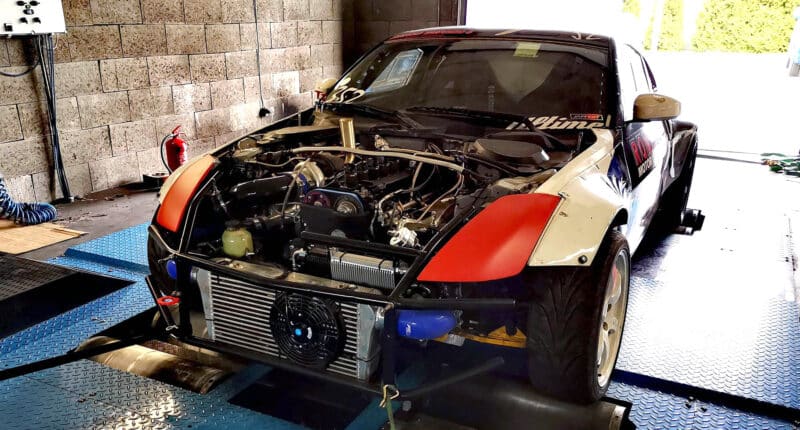There’s no doubt that the 350z is a very well liked rear-wheel-drive performance coupe. It also is the drift car of choice for many; one that you can turn into a supercar killer with the right upgrades.
But no matter what you do with your 350z, you’re stuck working within the confines of the existing motor, unless you swap it out for something more interesting.
There’s a lot to be said about the VQ V6 platform, but for those wanting something different or more powerful, there are many swap options to choose from.
Doing this is the ultimate way to get more out of your Z33 chassis, even if it requires a complete overhaul and a good chunk of change.
In this article, we’ll explore some of the most popular options, walk you through everything you need to know to complete the swap and give you the pros and cons of each option.
What Engine Is in a 350z?
Before you can dive too far into the 350z engine swap, you need to know what’s already in your 350z.
From 2003 to 2006, the 350z came with a VQ35DE engine, which puts out 313 horsepower at 6,800 rpm. It also has 3.5L of displacement and 268 lb-ft of torque at 4,800 rpm.
In 2007, they overhauled the 350z and installed a VQ35HR engine. This engine pushes 325 horsepower at 6,800 rpm and 268 lb-ft of torque at 4,800 rpm. It also has 3.5L of displacement.
Just keep in mind that while the engine specs are similar for these two engines, when you’re looking to complete an engine swap, it’s essential that you get the conversion kit for the right engine.
GM LS1
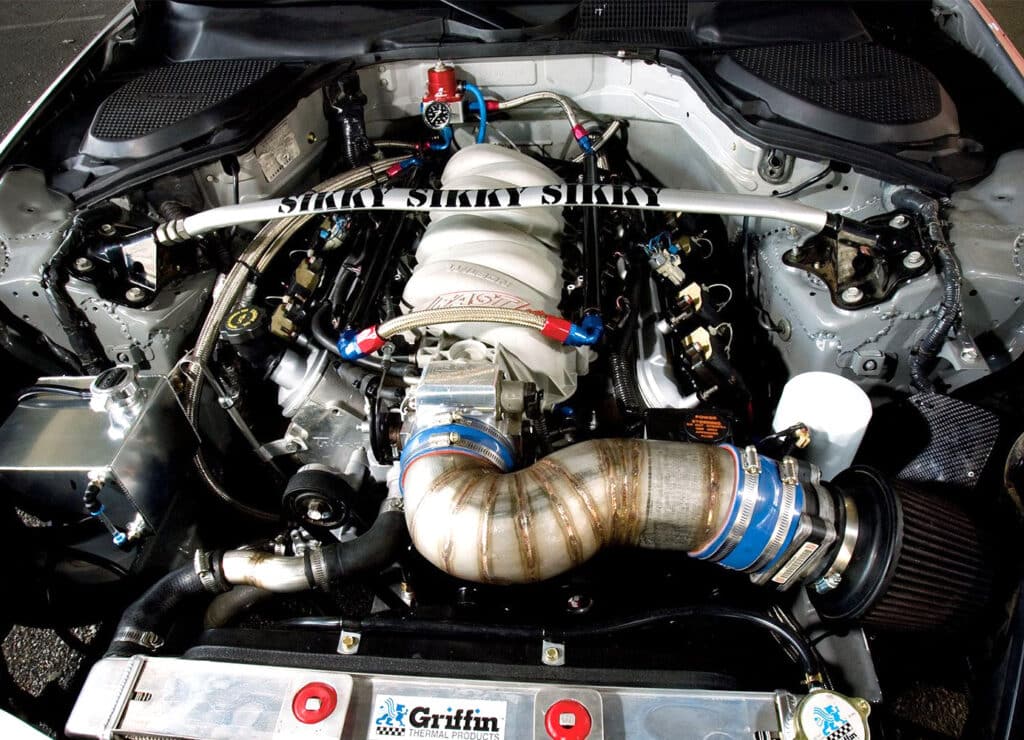
Engine Code: LS1
Layout: V8
Displacement: 5.7 L (5,665 cc)
Fuel System: Sequential fuel injection
Cylinder Bore: 99 mm (3.90 in)
Piston Stroke: 92 mm (3.62 in)
Compression Ratio: 10.1:1
Power: ~350 hp @ 5,600 rpm
Torque: ~365 lb-ft @ 4,400 rpm
Firing Order: 1-8-7-2-6-5-4-3
If you’re looking for one of the most popular 350z engine swaps out there, you can’t go wrong with a good old LS swap. It’s a full-blown 350z v8 swap, and while there are a lot of LS engines to consider, the LS1 is the most popular choice.
The reason for this is pretty simple. There are a lot of things you can do to get more out of an LS engine. With far more upgrade options out there, when you get an LS engine inside your 350z, it opens up a whole new world of possibilities.
There’s no doubt that you need quite a few components to make your LS1 engine swap work. We’ve made it easier for you to track down everything you need.
While some people put together a 350z LS swap kit for you to purchase, they usually charge you a little more for the convenience. Because of this, we recommend purchasing the following parts separately to save yourself some money:
- Engine mounts
- Transmission adapter
- Transmission shifter extension relocation kit
- Driveshaft
- Oil pan kit
- Headers
- Wiring harness
- Oil filter mounts
- Clutch line
- Master cylinder conversion kit
- Power steering line conversion kit
- Radiator
There’s a reason that LS engines are the most popular engine swap option for the 350z. There’s just so much you can do to customize the engine and get even more powerful results.
From turbochargers and superchargers to upgraded headers and intakes, the possibilities after you put in an LS engine are pretty much endless.
You can swap out parts with just about any LSx variation. With enough upgrades and money, there’s no reason you can’t push close to 1,400 horsepower on your new engine!
Not only do you get a very customizable engine with the LS1, but it’s also a relatively straightforward conversion. You order all the parts in the kit, and then it’s just on you to put in the work.
Finally, while no engine swap is cheap and the LS1 engine swap is certainly no exception, compared to other engine swap options it is a more affordable choice.
While there’s a lot to love with an LS1 350z engine swap, it’s not perfect. The first issue is that you’ll need to upgrade a few components to really get the performance results you want.
So, while the initial install is a relatively more affordable option, once you start throwing in all the upgrades to reach higher horsepower numbers, the price quickly adds up.
Moreover, while it’s a great engine swap option, there’s no doubt that it’s a more popular choice. Its popularity makes it a bit easier to get information and advice on this engine swap, but it also makes it a little less unique.
Toyota 2JZ and 1JZ
Engine Code: 1JZ-GE
Layout: Inline-6
Displacement: 2.5L (2491 cc)
Fuel System: EFI (Electronic Fuel Injection)
Cylinder Bore: 86 mm
Piston Stroke: 71.5 mm
Compression Ratio: 10.0:1
Power: ~200-220 hp (varies by generation)
Torque: ~185-195 lb-ft
Firing Order: 1-5-3-6-2-4
Another extremely popular 350z engine swap option is either a 1JZ or a 2JZ. These are especially popular options for the ’03 to ’06 350z simply because of how easy it is to complete the swap.
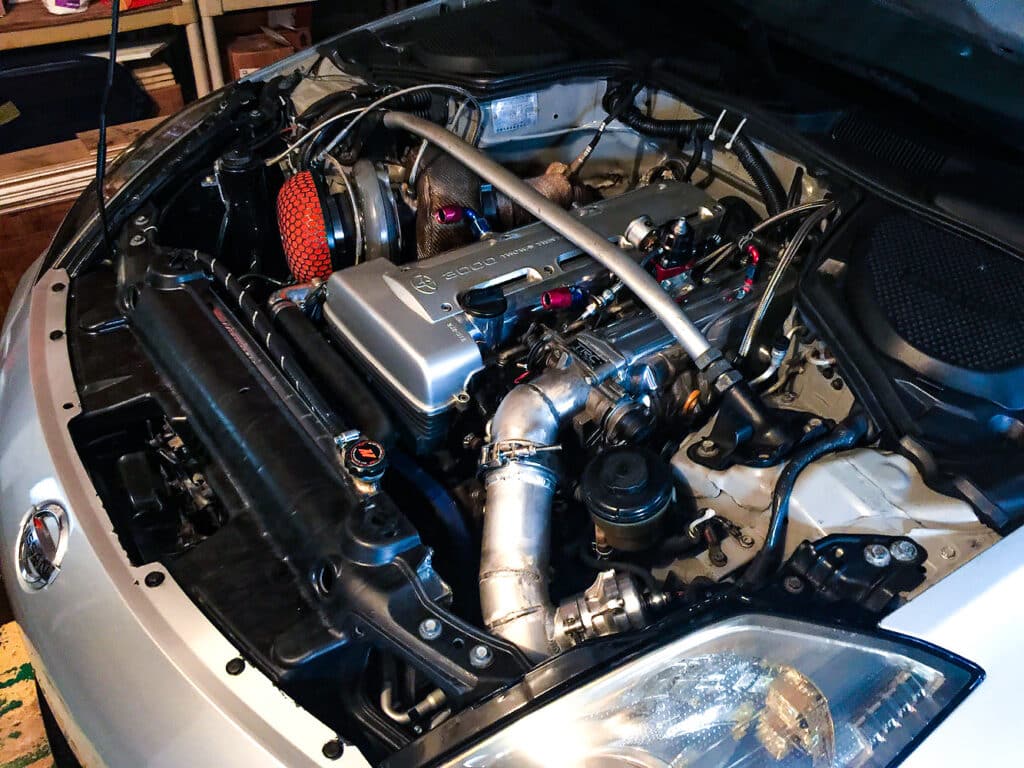
Engine Code: 2JZ-GE
Layout: Inline-6
Displacement: 3.0L (2997 cc)
Fuel System: EFI (Electronic Fuel Injection)
Cylinder Bore: 86 mm
Piston Stroke: 86 mm
Compression Ratio: 10.5:1 (VVT-i variants), 10.0:1 (non-VVT-i)
Power: ~215-230 hp (varies by market and generation)
Torque: ~210-220 lb-ft
Firing Order: 1-5-3-6-2-4
There are complete 2JZ and 1JZ 350z swap kits, and from there it’s just up to how you want to build the engine to get the most from it. There are plenty of build options that can give you between 600 and 1,000 horsepower if you’re willing to drop the money!
If you’re debating between the 1JZ and 2JZ engine, we recommend going with the 350z 2JZ swap. While both engines are impressive, a 2JZ swapped 350z has the potential for a bit more low-end torque due to the higher displacement numbers in the 2JZ.
Still, if all you can get your hands on is the 1JZ, you’re going to have an engine that you love driving day after day and year after year.
While they offer a pretty extensive kit for a 350z to a 1JZ or 2JZ engine swap, they’re not all-inclusive. The best kit on the market is the Collins Performance Technologies JZ to 350z Swap Kit.
The kit includes:
- Adapter plate
- CNC’d 1-piece flywheel
- Twin-disc clutch pack
- ARP flywheel bolts
- Flywheel adapter
- Pilot bushing
- Adapter plate bolts
- Clutch release bearing
- A bearing face converter
But while that’s a pretty comprehensive kit and comes with just about everything you’ll need, there are a few more components you’ll need to get to complete the job. The additional components you’ll need are the following:
- Stock automatic flex plate (Toyota part #32101-22050 56907)
- Stock automatic flex plate spacer
- Transmission adapter bolts
Once you have all these components and your new 1JZ or 2JZ engine, the swap itself is pretty straightforward and is relatively simple to complete.
There’s a reason swapping to a 1JZ or a 2JZ engine is so popular. First and foremost is the extremely easy conversion. The second advantage is the price.
Finally, while these are great engines all on their own, one of the perks of swapping to these engines is all the customization options that you can get your hands on.
While there’s a ton to love about the 1JZ or 2JZ engine swap, there are a few reasons people choose to go a different route. First, it’s still a V6 engine. While it’s a durable block with a ton of potential, you’re not going to get that signature V8 feel and sound.
Moreover, without more upgrades, the output is actually extremely similar to the stock engine. That means after all your work to swap the engines, you’ll have to do some more if you want significant power upgrades.
Nissan RB26DETT
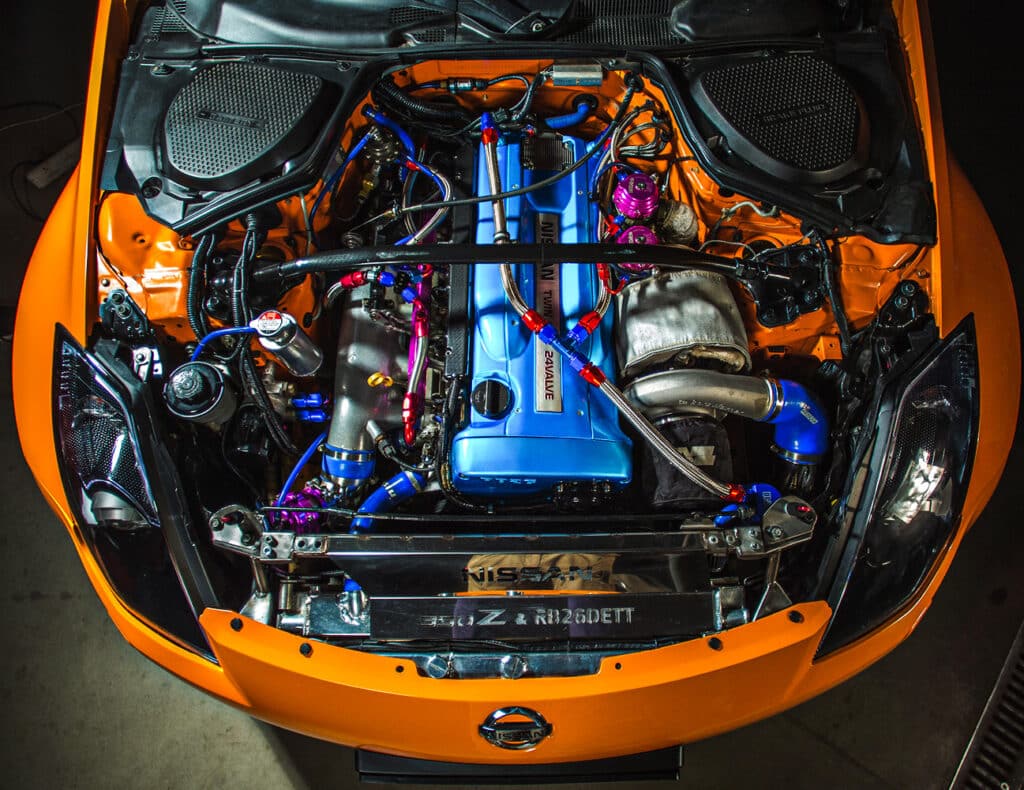
Engine Code: RB26DETT
Layout: Inline-6
Displacement: 2.6L (2568 cc)
Fuel System: Multi-point EFI
Cylinder Bore: 86 mm
Piston Stroke: 73.7 mm
Compression Ratio: 8.5:1
Power: ~276 hp (officially, often exceeds 300 hp in reality)
Torque: ~260 lb-ft
Firing Order: 1-5-3-6-2-4
The RB26-DETT is an inline six-cylinder engine more commonly found in the Nissan Skyline, which means you’re at least staying with the same brand when you’re using this engine.
But don’t let that fool you, there’s little to no cross-compatibility, making it one of the most complicated builds out there. As with any 350z engine swap, you need to know what you’re getting yourself into before you start pulling or ordering parts.
When you’re buying your RB26 engine, you’ll need to ensure the following parts are in working condition, especially if it’s coming from a donor Skyline:
- Transmission
- ECU
- Wiring harness
- Manifold
- Turbos
If you don’t get these parts with your engine, you’ll need to track them down separately, and sometimes this can be more of a headache than it’s worth, and it’s going to drive up your cost a bit.
Like with any engine swap, not only will you need all those parts, but you’re going to need to do a little more to mesh up those components and get everything else to work.
Finally, while you’ll certainly need all those things, we’re not promising that they’re all you’ll need. That’s because a lot of this engine swap is just fabricating parts and making things fit, and that requires creativity and flexibility on the fly.
You’re probably not going to find a full RB26 350z engine swap kit, it’s up to you to figure it out and make it work.
There’s no denying that the RB26 is a unique build, and if that’s what you’re going for, it’s a fine choice. Not only is it unique, but there’s undoubtedly some power potential there.
These engines can push up to 500 horsepower at the wheels, and that’s no small feat. However, there is a reasonable argument that both stock 350z engines can reach these horsepower demands.
There’s also the fact that the RB26 is an engine that many enthusiasts love, and some people just want one of their favorite engines in their favorite cars. Still, a unique engine with a higher potential power output is the allure of the 350z.
All it takes is a look at a few 350z forums to see that it’s one of the more controversial engine swap options. And while many enthusiasts don’t go about voicing their complaints with this build the right way, the complaints themselves are still valid.
If you’re swapping to a 350z engine, you’re not really getting any extra horsepower gains than you could get out of the stock engines, especially considering how much you’re spending.
With that in mind, the cost is certainly a significant downside to an RB26 engine swap. Not only is the motor itself a little harder to track down and a bit more expensive.
All this means is that it’s a more expensive build, and it requires a little more automotive knowledge and expertise to get it done.
The critics claim you’re doing all this for a build that you could get better results from with a different setup. They’re not wrong, but if you’re looking for something unique and love the RB26, ignore the critics.
Nissan VK56DE
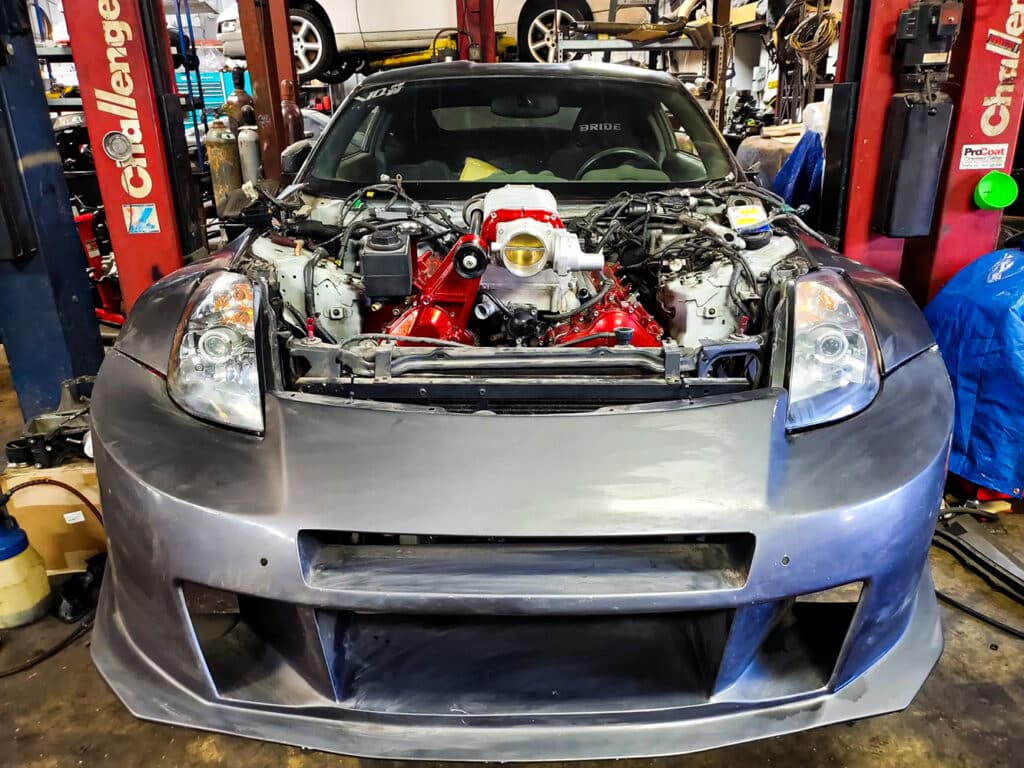
Engine Code: VK56DE
Layout: V8
Displacement: 5.6L (5552 cc)
Fuel System: EFI (Electronic Fuel Injection)
Cylinder Bore: 98 mm
Piston Stroke: 92 mm
Compression Ratio: 9.8:1 (DE), 11.2:1 (VD with VVEL)
Power: ~305-400 hp (varies by model)
Torque: ~375-420 lb-ft
Firing Order: 1-8-7-3-6-5-4-2
The Nissan VK56 is another unique engine swap option you have for your 350z, but to many enthusiasts, this one makes a little more sense.
Since it’s a far more unique build, you’re not going to find many kits or even parts for this engine swap. That’s part of what makes this such a unique build, but it’s also why so many people stay away from it entirely.
While we’ve done our best to highlight everything you’ll need to complete each engine swap option up to this point, the truth is that if you’re looking to complete a VK56 350z engine swap, you’ll need to learn how to fabricate quite a few parts.
That’s because there aren’t many complete 350z VK56 swap kit on the market. Instead, it’s up to you to fabricate, cut, weld, and figure just about everything out.
However, it’s certainly possible, as we’ve seen a few completed VK56-swapped Z33s. Just know that it will take a lot of work, fabrication, and time to get the job done.
It’s also a build without a ton of guidance out there for you. You can find some people willing to help you figure it out, but it’s simply not the easiest swap and not a lot of people have the experience necessary to give you the advice you actually need.
It’s unique in large part because of how complicated the job is, but once you finish the job, it’s unlikely that you’ll see any other VK56 swapped 350zs at your next meet.
Not only that, but you are getting a V8 engine in your 350z, and that opens up a whole world of possibilities. It’s possible to get well over 500 horsepower with this build, and with an estimated 600 lb-ft of torque, there’s nothing lacking there either.
It’s this mix of power and uniqueness that draws people to the 350z. Of course, some people just like the challenge that this unique build offers, and there’s nothing wrong with that either!
Should You Engine Swap a VQ35DE for a VQ35HR?
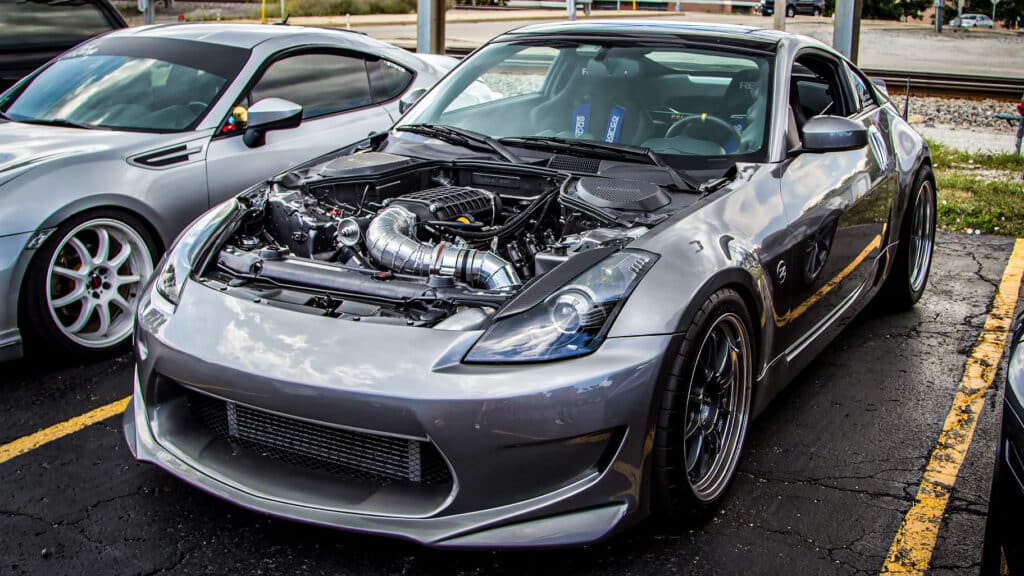
Look, if you’re looking to complete a 350z engine swap and think that the easiest way to get the job done is to go from a VQ35DE to a VQ35HR. It’s the same car, just different model years so it should be fairly easy right?
You’re not the first person to think this way, and you won’t be the last, but there are garages littered with half-finished swaps and malfunctioning 350zs after their owner tried to piece this swap together.
We’ll highlight what you’d need to do to get the job done here, but we highly recommend going with a different 350z engine swap instead of trying to complete this one.
To get this swap done you’ll need a lot of parts from a VQ35HR. Of course, you’ll need the engine, but you’ll also need all these parts from a VQ35DE:
- ECM
- Radiator
- Steering rack
- Starter
- Intakes
- Fuel lines
- Transmission
- Clutch
And even when you source all these parts, that’s when the real challenge begins. Because Nissan completely redesigned just about everything for the VQ35HR, you’ll have to completely rewire the electrical harness to get everything to work properly.
The only real advantage of completing a VQ35DE to VQ35HR engine swap is that you get to say you figured it out. Tons of people have tried, but it seems like failure after failure is all that’s out there.
You’ll get to tell the naysayers “I told you so,” but you’ll still have to deal with the other question of “why?” Still, completing the build is an accomplishment all on its own.
It’s expensive, it’s extremely challenging to complete, and the performance gains you get are minimal compared to the amount of money and effort you’re dumping into the vehicle.
There’s a reason forum after forum screams at you to stay away from this engine swap. Add our voice to the mix.
Our Top Recommendation
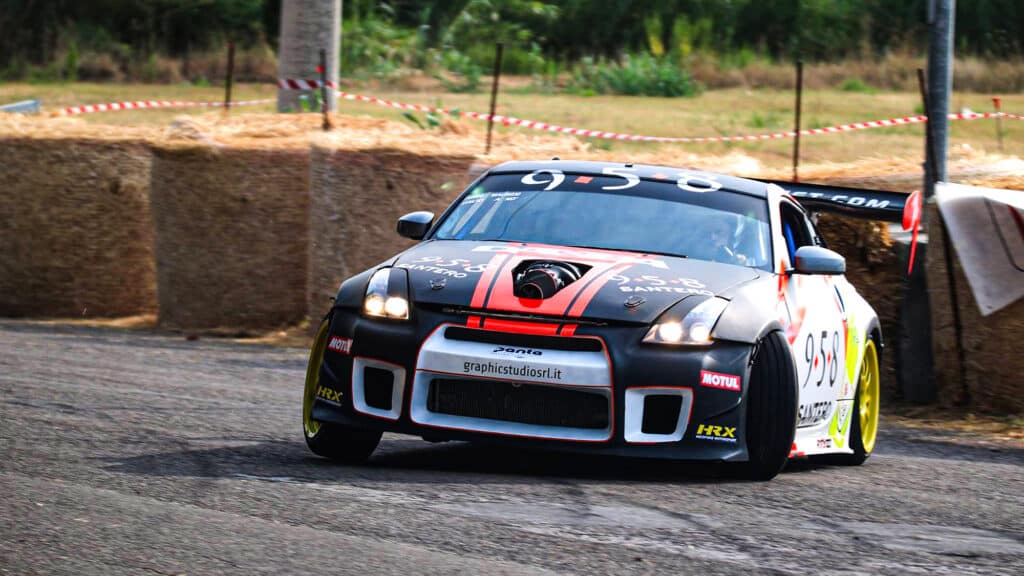
If you’re thinking about completing a 350z engine swap, we highly recommend going with an RB26-DETT or 2JZ swap. They’re among the most popular options for a reason, and no matter what your power goals are, there’s an option here for you.
Have you completed a 350z engine swap or do you have a question for us about what you need to do? We’d love to hear from you, so go ahead and drop a comment below.
